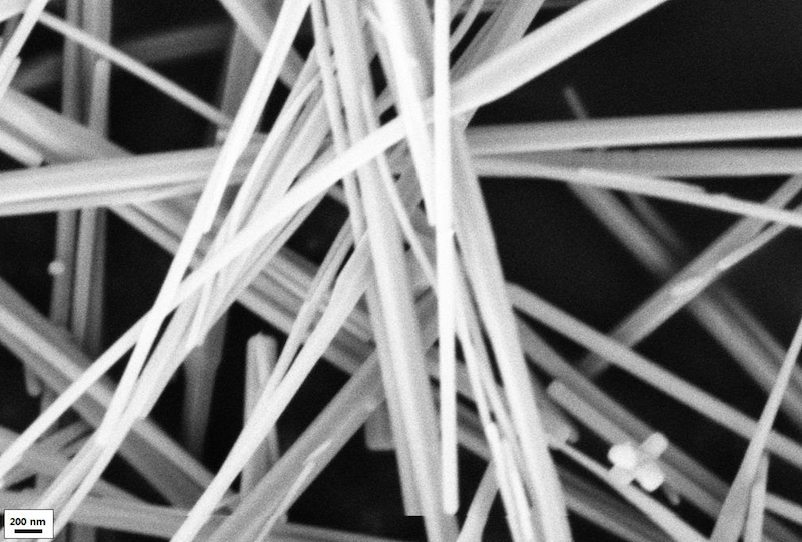Zinc Oxide (ZnO) Nanowire
Zinc oxide (ZnO) is a semiconductor with a wide band gap (3.37 eV) and a high-exciton binding energy (60 meV).1 Based on its unique properties, researchers have studied its potential application for optoelectronic devices, field emitters, solar cells, sensors and transparent electrodes.2 ZnO is a versatile functional material that has a diverse group of growth morphologies, such as nano-combs, nano-rings, nano-helixes or nano-springs, nano-belts, nanowires and nanocages.3 Of these various nanostructures, ZnO nanowires are of greatest interest due to their quasi one-dimensional (1-D) structure that exhibits quantum confinement effects and high surface to volume ratios. The nanowires can be considered a 1-D channel for absorption, emission, and transport of electrons, holes, and photons. The special geometric structure can lead to strong confinement effects on the carriers and photons, which could result in various novel optical and electrical properties for device applications such as short wavelength LEDs and lasers of nanometer size.4 A number of potential applications have emerged in areas such as low-voltage and short-wavelength optoelectronics, photonics5, actuators, magnetic materials and solar cells,6 etc..
ZnO nanowires are commonly synthesized by chemical vapor deposition (CVD)7, physical vapor deposition8, electrodeposition9,10, thermal evaporation11, aqueous synthesis12 and solvothermal technique13. However, Using catalysts to grow aligned ZnO nanorods14 may leave some catalyst impurities into the nanostructures, possibly contaminating the purity of ZnO nanorods and influencing their properties.2 There still exists a need to develop a method to produce ZnO nanowires in great quantities because large-scale production is an initial term in the process of widespread commercialization of ZnO nanowires.15
ACS Material used a simple but effective method to produce large quantities of ZnO nanowires. Mixed ZnO and activated carbon powder were used as source materials, synthesized ZnO nanowires through gas phase method. We offer high-quality ZnO nanowires with a hexagonal cylindrical single crystal structure. The wire diameters range between 50-120 nm and lengths between 5-50 µm while the aspect ratio is 300-500 (Figure 1).

Figure 1 SEM image of ACS Material ZnO nanowires
ACS Material Products:
Reference
1. Service, Robert F. "Will UV Lasers Beat the Blues?." Science 276.5314(1997):895-895.
2. Lin, Chih Cheng, and Y. Y. Li. "Synthesis of ZnO nanowires by thermal decomposition of zinc acetate dihydrate." Materials Chemistry & Physics 113.1(2009):334-337.
3. Zhong Lin Wang. "Zinc oxide nanostructures: growth, properties and applications." Journal of Physics-Condensed Matter 16.25(2004):829-858.
4. Jingbiao Cui. "Zinc oxide nanowires." Materials Characterization 64. Complete(2012):43-52.
5. Zhou, Qiong, et al. "Synthesis of Vertically-Aligned Zinc Oxide Nanowires and Their Application as a Photocatalyst." Nanomaterials 7.1 (2017): 9.
6. Balela, Mary Donnabelle L., et al. "Formation of zinc oxide nanostructures by wet oxidation of vacuum deposited Zn thin film." Optical and Quantum Electronics 49.1 (2017): 3.
7. Zhang, Daqing, et al. "Experimental Study of Electrical Properties of ZnO Nanowire Random Networks for Gas Sensing and Electronic Devices." Applied Physics A 100.1(2010):145-150.
8. Zhu, G., et al. "Flexible high-output nanogenerator based on lateral ZnO nanowire array." Nano Letters 10.8(2010):3151.
9. Lupan, O., et al. "Well-aligned arrays of vertically oriented ZnO nanowires electrodeposited on ITO-coated glass and their integration in dye sensitized solar cells." Journal of Photochemistry and Photobiology A: Chemistry 211.1 (2010): 65-73.
10. Alchaar, Rodolphe, et al. "Enhanced UV photosensing properties of ZnO nanowires prepared by electrodeposition and atomic layer deposition." Journal of Solid State Electrochemistry (2017): 1-10.
11. Mute, A, et al. "Structural and optical characterization of ZnO nanowires grown on alumina by thermal evaporation method." J Nanosci Nanotechnol 10.10(2010):2669-2673.
12. Breedon M, Rahmani M B, Keshmiri S H, et al. Aqueous synthesis of interconnected ZnO nanowires using spray pyrolysis deposited seed layers[J]. Materials Letters, 2010, 64(3):291-294.
13. Alshehri, Naif Ahmed, et al. "Investigation of the growth parameters of hydrothermal ZnO nanowires for scale up applications." Journal of Saudi Chemical Society (2017).
14. Ma, Siwei, and Adrian H. Kitai. "Chemical vapor deposition-based growth of aligned ZnO nanowires on polycrystalline Zn2GeO4: Mn substrates." Journal of Materials Science (2017): 1-11.
15. Zhou, Zhihua, et al. "Rapid mass production of ZnO nanowires by a modified carbothermal reduction method." Materials Letters 65.5(2011):832-835.